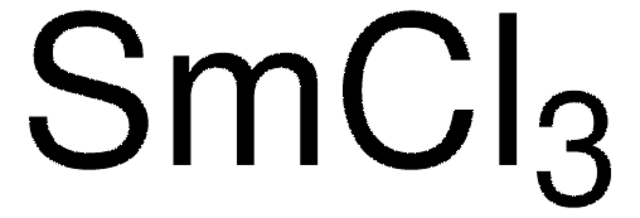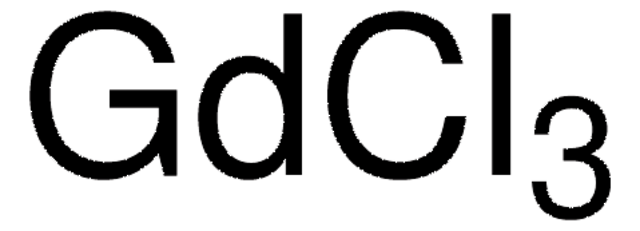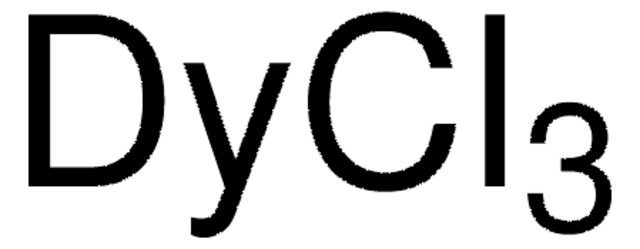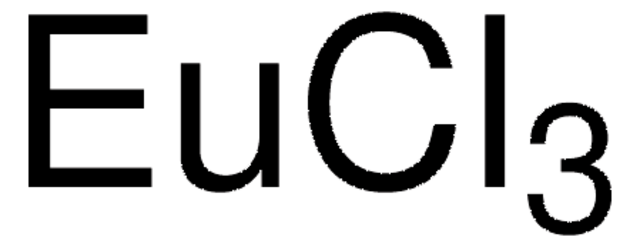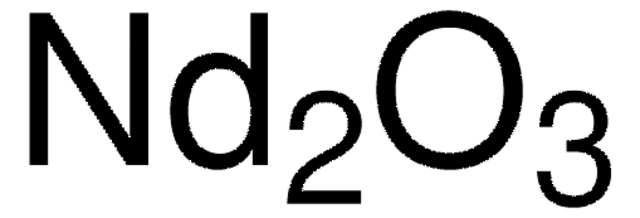Wichtige Dokumente
449946
Neodym(III)-chlorid
anhydrous, powder, ≥99.99% trace metals basis
Synonym(e):
Neodymium chloride, Neodymium trichloride
About This Item
Empfohlene Produkte
Qualität
anhydrous
Qualitätsniveau
Assay
≥99.99% trace metals basis
Form
powder
Eignung der Reaktion
reagent type: catalyst
core: neodymium
Verunreinigungen
≤100.0 ppm Trace Rare Earth Analysis
mp (Schmelzpunkt)
784 °C (lit.)
Dichte
4.134 g/mL at 25 °C (lit.)
SMILES String
Cl[Nd](Cl)Cl
InChI
1S/3ClH.Nd/h3*1H;/q;;;+3/p-3
InChIKey
ATINCSYRHURBSP-UHFFFAOYSA-K
Suchen Sie nach ähnlichen Produkten? Aufrufen Leitfaden zum Produktvergleich
Anwendung
- Fluorine-free organic electrolytes for the stable electrodeposition of neodymium metal: This study investigates alternative electrolytes for neodymium metal deposition, aiming for more sustainable battery manufacturing processes (Geysens et al., 2023).
- The use of artificial neural network (ANN) for modeling adsorption of sunset yellow onto neodymium modified ordered mesoporous carbon: Highlights the use of Neodymium(III) chloride in advanced adsorption processes for environmental applications, modeling the interactions using ANN (Ahmad et al., 2020).
Zubehör
Signalwort
Warning
H-Sätze
Gefahreneinstufungen
Eye Irrit. 2 - Skin Irrit. 2 - STOT SE 3
Zielorgane
Respiratory system
Lagerklassenschlüssel
11 - Combustible Solids
WGK
WGK 2
Flammpunkt (°F)
Not applicable
Flammpunkt (°C)
Not applicable
Persönliche Schutzausrüstung
dust mask type N95 (US), Eyeshields, Gloves
Hier finden Sie alle aktuellen Versionen:
Besitzen Sie dieses Produkt bereits?
In der Dokumentenbibliothek finden Sie die Dokumentation zu den Produkten, die Sie kürzlich erworben haben.
Kunden haben sich ebenfalls angesehen
Artikel
The rare earth elements impact nearly everyone in the world. All of the people living in advanced technological countries and almost all those living in third world countries utilize the rare earths in their everyday living—the car that one drives (gasoline is refined from oil using rare earth catalysts and catalytic converters reduce the polluting emissions from the automotive exhaust), watching the news on TV (the red and green colors in TV screens), the telephones and computers we use to communicate (the permanent magnets in speakers and disc drives), just to name a few examples.
Unser Team von Wissenschaftlern verfügt über Erfahrung in allen Forschungsbereichen einschließlich Life Science, Materialwissenschaften, chemischer Synthese, Chromatographie, Analytik und vielen mehr..
Setzen Sie sich mit dem technischen Dienst in Verbindung.

